A longing for the beauty of high peaks, and an unshakeable faith.
I awoke to a clear sky full of stars, the mist covering the mountains completely gone. Straight ahead, the large black shadow cast by Mt.Tsurugi with its rows of craggy peaks appears to be sinking into the darkness. The light of the stars dims as the eastern sky gradually becomes steeped in yellow, the mountains ready to quietly usher in the morning. Mt.Tsurugi, the “rocky palace” gouged out by glaciers. As told in Jirō Nitta’s novel “Tsurugi-dake – Ten no gi”, it was as recent as 1907 that government surveyor Shibasaki Yoshitaro reached the top of this craggy peak.
However, at the top he and his cohorts discovered a rusty iron sword and copper bishop’s staff. These were in fact left by mountain ascetics during the Heian period, and the fact that there were no recorded summits until Shibasaki bagged it attests to the fact that Mt.Tsurugi was a mountain that people thought best left alone. Perilous sections still remain, and the variation routes draw in hordes of hardy climbers.
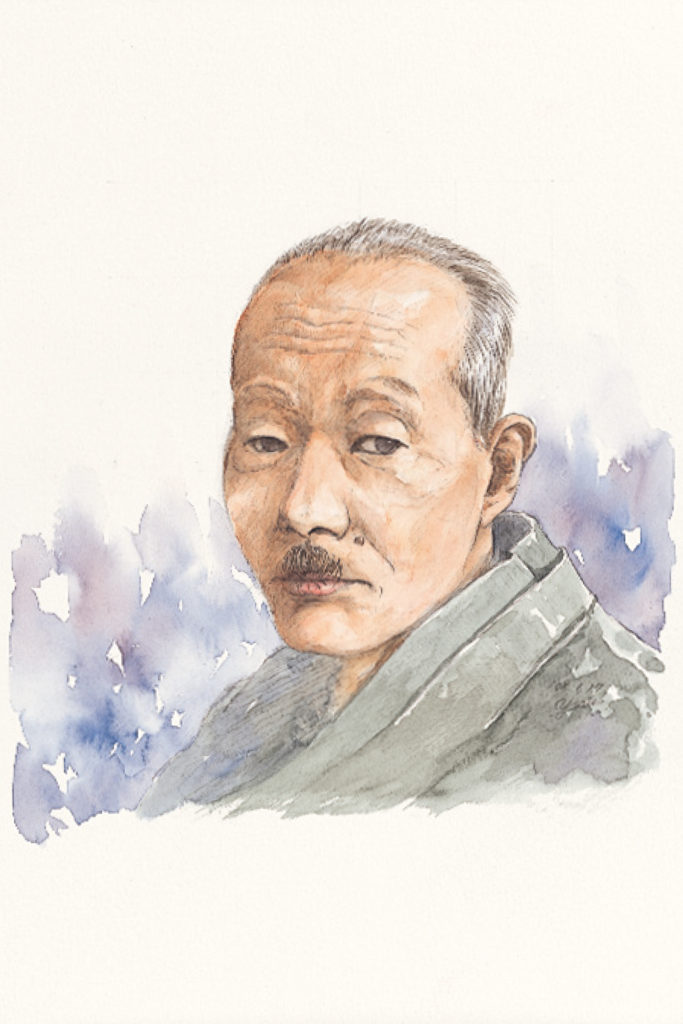
illustration | Yohei Naruse
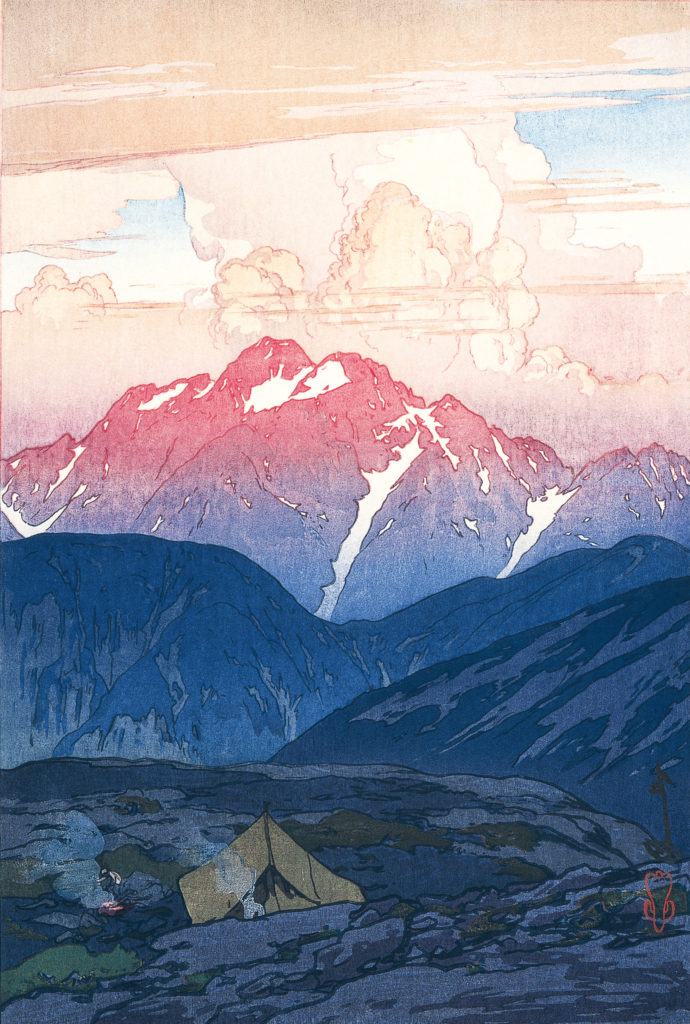
Throughout the Taishō era, when summer came Hiroshi Yoshida would confine himself to the Japan Alps for several months at a time, wandering through the mountains and sketching. One of his most epic walks was a 30-day traverse taking in Mt.Tsurugi onto Mt.Tateyama, followed by Mt.Yakushi, passing through Kumanotaira and descending along the Takase river. There were five in his group, including the laborers carrying their luggage. Hitting the trail at the end of the rainy season, the group went up the Hayatsuki river which flows to the west of Mt.Tsurugi, and set up camp on the riverside. Alas, the following day they were waylaid by rain. The rain finally abated on the third day, enabling them to cross the swollen river using wire. Bedding down in a cavern just in front of the Omado Glacier, they would have descended along the Tsurugi river (probably Tsurugi marsh) through the snowy valley before coming into Mita Daira, meaning they would have skirted around the summit. He apparently visited Mita Daira where the current Tsurugisawa mountain hut is located on several occasions, and both “Tsurugi Mountain” exhibited at the Imperial Academy art exhibition in 1932 and the “Tsurugi Mountain” woodblock print exhibited in 1936 show the view as seen from around Mita Daira. In any case, in a time where the route would have been sketchy at best, it was a tall order to maneuver throughout the mountains carrying unwieldly luggage a great deal heavier than that of today. What exactly was it that impelled Hiroshi Yoshida to persist with these long mountain expeditions?
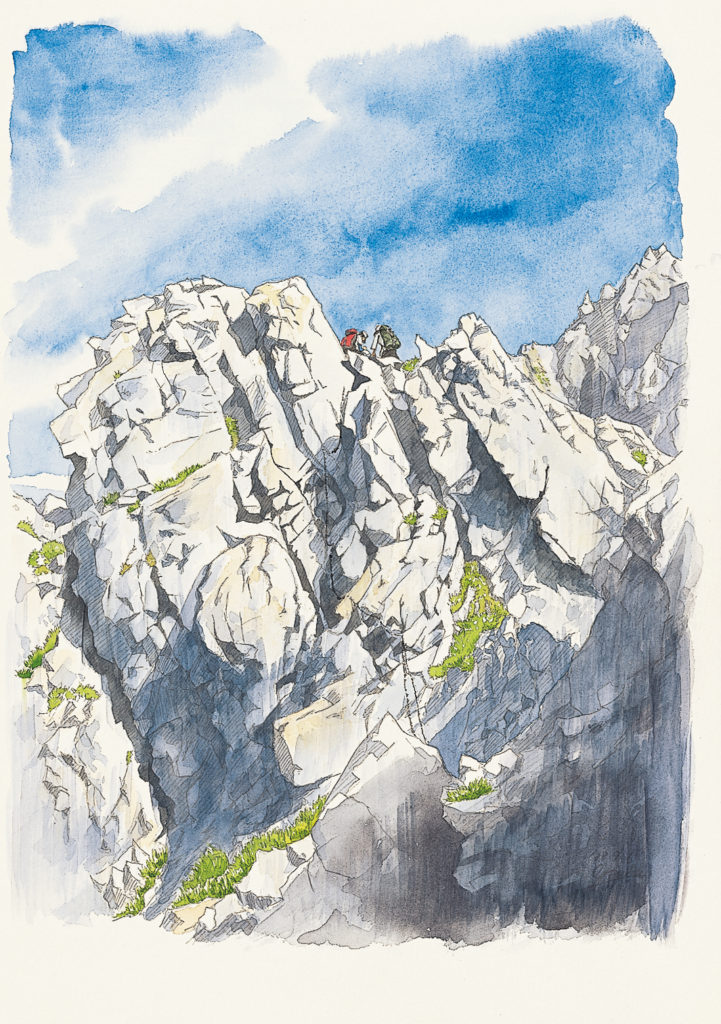
illustration | Yohei Naruse
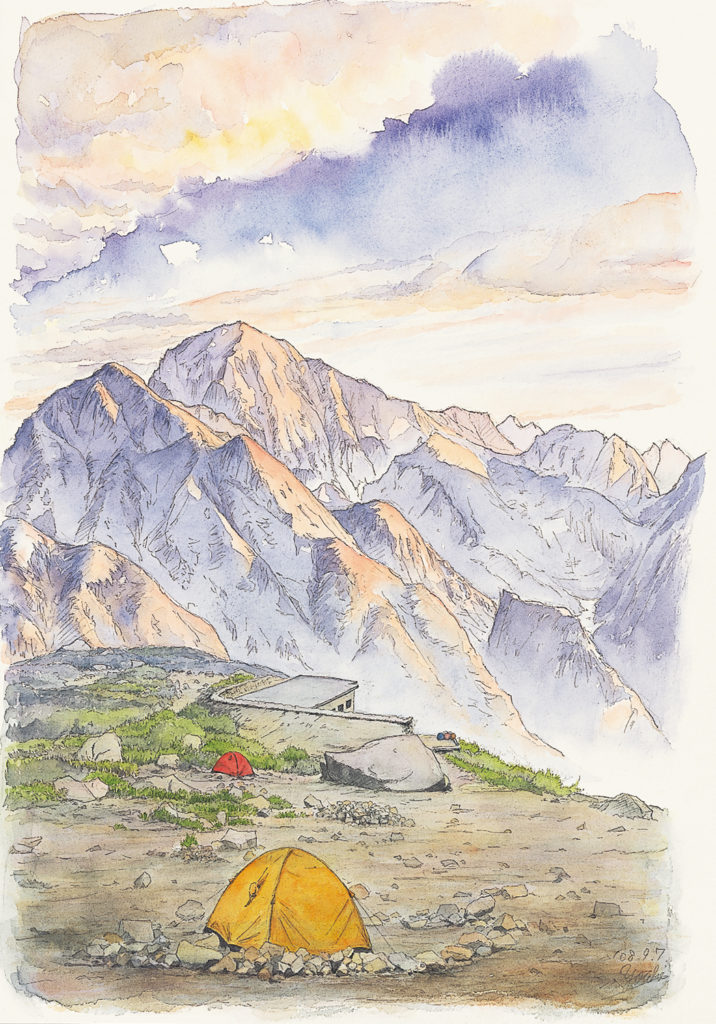
illustration | Yohei Naruse
The morning sun gradually tinges the rock face, and the form of Mt.Tsurugi comes into view. Tsurugi viewed from Tsurugi-sawa campsite, however, is different in form to the “Morning at Mt.Tsurugi” sketched by Hiroshi Yoshida. The proprietor of the mountain hut informs me that Yoshida’s famous depiction was actually done from Mt.Kashimayari to the east. For certain, from Kitazawa hut where Mt.Tsurugi is to the north, when Mt.Tsurugi is bathed in sunlight the western side in dark, while in “Morning at Mt.Tsurugi”, the entire mountain is resplendent in the morning light. Which means the snowy valley painted on the far right is Komado-snowy valley, with the Sanno-mado snowy valley on the left, and above is Yatsu-mine, a series of craggy peaks.
Passing through the valley, the morning light is dazzling. Although Mt.Tsurugi is notorious among mountaineers for its steep and precipitous form, with the grassland all around and the blue sky above, it looks surprisingly idyllic. Passing Kenzansou hut marks the start of the chains, as the real Mt.Tsurugi makes itself known. After Mt.Maetsurugi, one is faced with the imposing main peak which might as well be called a cluster of rocks. If you squint you can make out the figure of people clambering up the middle of the rock, and confirm the route. Successfully negotiate the most perilous spot known as the “Kani no Tatebai” (meaning “vertical crab crawl”), and you soon find yourself at Tsurugi’s spacious summit. In no time at all the summit is engulfed in vapor, while the rocky crags of Yatsumine protrude a gloomy shadow upwards, steeped in mysterious profundity.
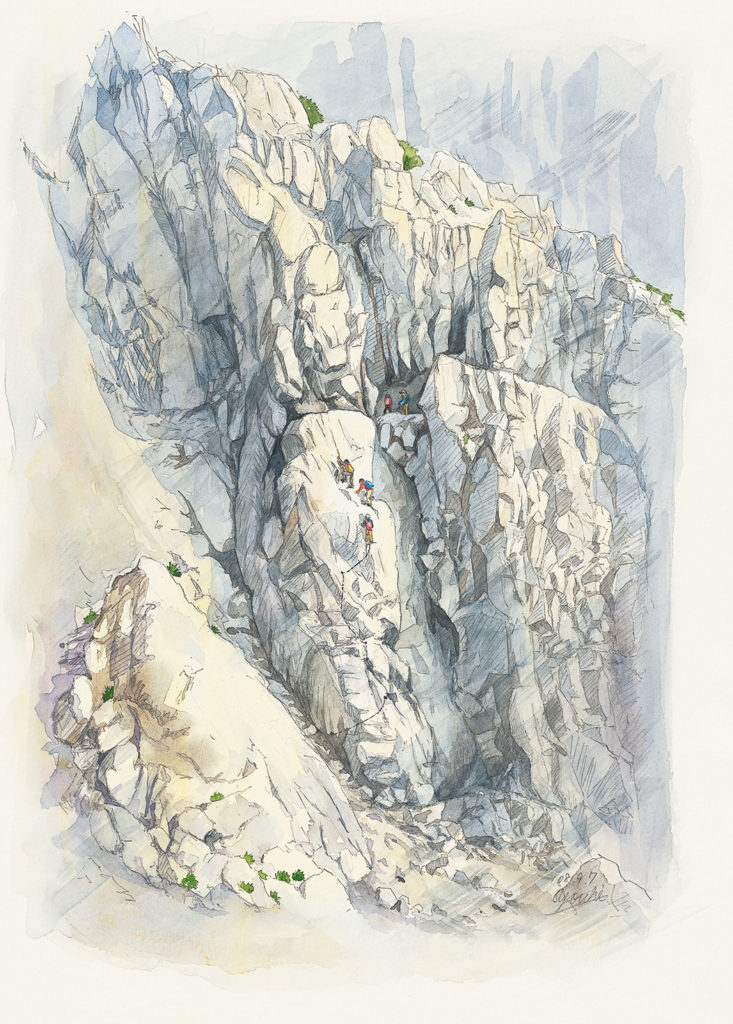
illustration | Yohei Naruse
In the 27th year of Meiji (1894), 18-year-old Hiroshi Yoshida had come to Kyoto, and enrolled in the Fudō-sha painting school run by Koyama Shōtarō. The school organized 2~3-night excursions for drawing from every spring and autumn, but already being possessed with a strong sense of wanderlust to begin with, Yoshida went off on his own excursions into the mountains. One of these trips proved to be highly significant for 20-year-old Hiroshi Yoshida, who carried on drawing nature for the rest of his life. This was a 2-month nature-sketching excursion deep into the Oku-Hida mountains planned with Banka Maruyama. During this epic walk which covered some 150 km from Shinshu all the way to Hidatakayama, the two of them bushwhacked into various mountains in the belief that the true allure of the mountains could only be found in untrodden deep valleys. As well as sleeping under the stars, the two had to spend nights sheltered from the rain, subsisting on bush tucker such as nuts, berries and weeds. Despite being midsummer, they wore padded jackets festooned with dirt and lice, grew shaggy beards and let their hair grow wild. The fact that they were so disheveled upon emerging into a village that they were subject to inquisition by the local police is a testament to their unshakeable conviction that fully immersing themselves into nature was the only way to depict it in its truest form.
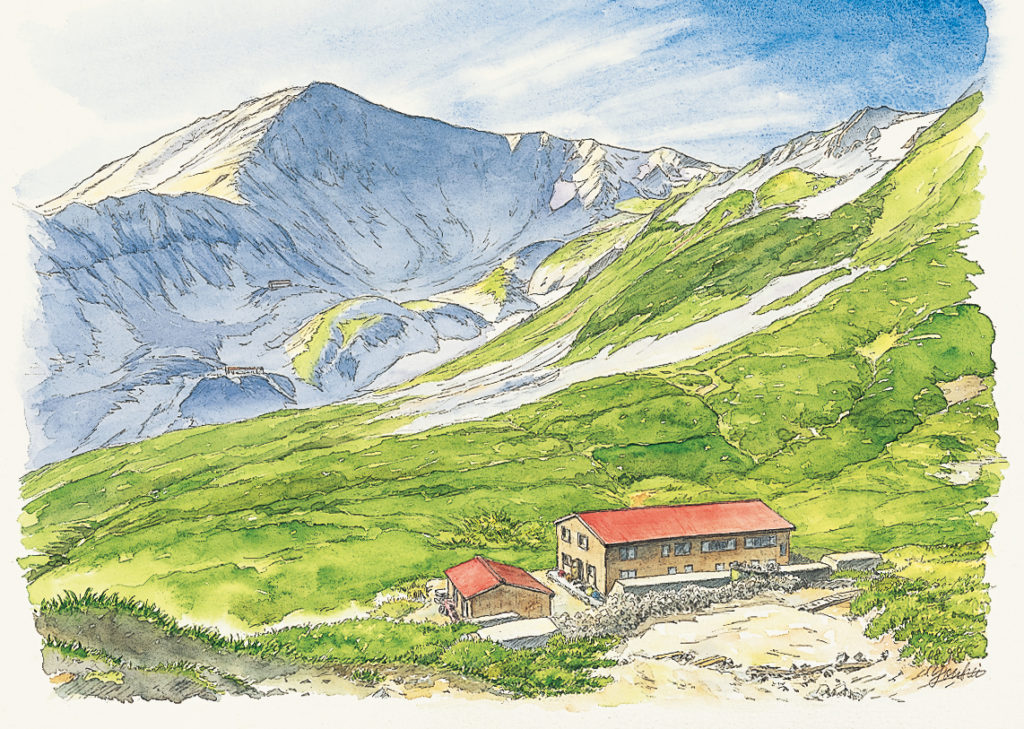
illustration | Yohei Naruse
“Scaling peaks and painting are right now something inseparable from my lifestyle. Painting is my vocation, and nothing has ever swept me away as the many mountain vistas that I have painted. The more you appreciate mountain scenery, the more you realize that there is a profound beauty in mountain landscapes. Mountains do not exist merely to be climbed. Instead, one should climb up and allow oneself to perceive the infinite beauty that lies within. This is surely the ultimate rapture of mountain climbing.”
So deeply moved by mountains that they feel immense joy in reproducing their beauty on canvas, these mountain painters painstakingly waited hours upon days for those fleeting moments of beauty such as the rising of the sun or the instant that the mist finally clears. They were slowed down by the wind and rain, only moving again when the weather improved. Entrusting themselves to the law of the mountains, they thoroughly immersed themselves amongst the peaks and painted incessantly. The deep awareness of nature developed during the secluded retreat to Okuhida was deeply rooted, and they presumably felt that secluding oneself in the mountains for extended periods of time was necessary to properly get off the beaten track.
The rain that has fallen since noon abates during the night, and blue skies greet us the following morning. The sky above Mt.Tsurugi is lurid with clouds tinged with a wealth of colors. With everything packed, I don my rucksack. With Tsurugi behind me, I slowly begin the climb into the valley, as yet untouched by the morning sun.
<PAPERSKY no.27(2008)>
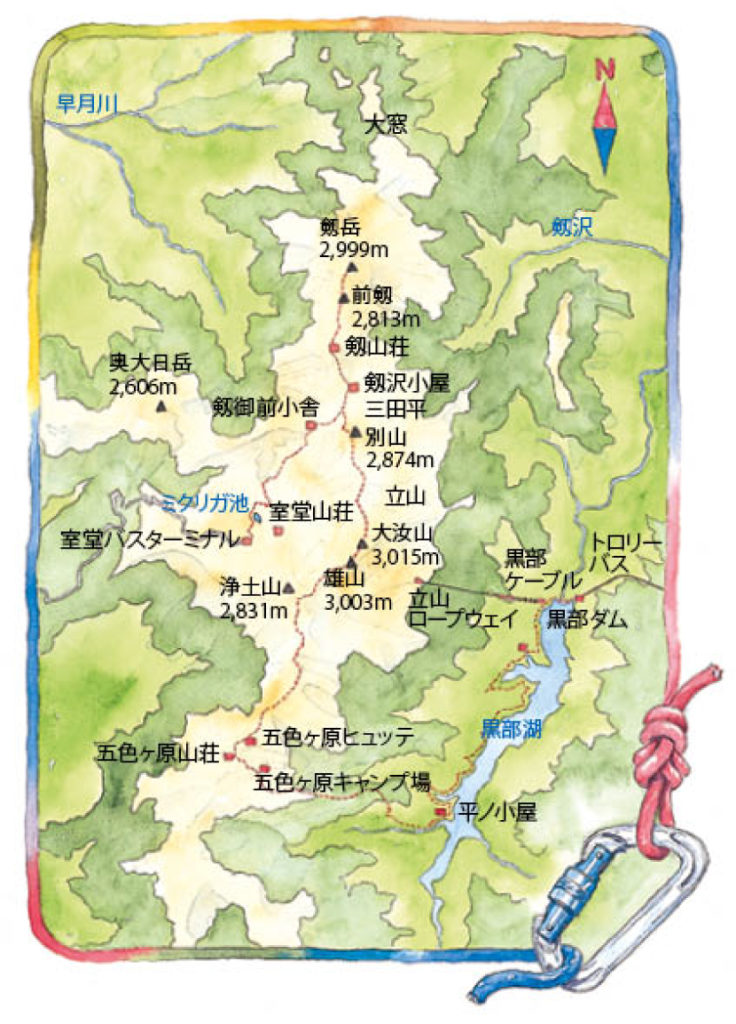
route information
The most popular route up Mt.Tsurugi involves hiking from Murodo to Tsurugigozen hut, and then staying in either Tsurugisawa hut or Kenzanso hut before bagging the summit the following morning. A round-trip from Tsurugisawa hut to the summit takes around 5.5 hours, but this greatly depends on stamina, how busy the rocky sections are, as well as the weather and the state of the rock surface. Although the chains are firmly affixed to the rocks, take great care if not accustomed to clambering up rocks. They become perilously slippery during the rain, and it would not be wise to aim for the summit in rain. The rocky section has separate routes for ascending and descending, the former being the “Kani no Tatebai” and the latter the “Kani no Yokobai” (meaning “crab vertical crawl” and “crab horizontal crawl” respectively). As the name implies, this involves crawling along an exposed ledge, and is a well-known white-knuckle spot. Murodo has for eons been known as a hub for the Tateyama faith. It is also an onsen spot, and various mountain huts allow day trippers to soak in their thermal waters. The spa with a view of Mt.Tateyama is simply exceptional.
Yohei Naruse
Born in Gifu Prefecture in 1982. Graduated Tsuru University, Graduate School. Following a stint in advertising, he currently works as a freelance writer and illustrator.











